SnO2-Based Memory Device with Filamentary Switching Mechanism for Advanced Data Storage and Computing
Abstract
:1. Introduction
2. Experimental Procedures
3. Results and Discussion
4. Conclusions
Author Contributions
Funding
Data Availability Statement
Conflicts of Interest
References
- Nawrocki, R.A.; Voyles, R.M.; Shaheen, S.E. A Mini Review of Neuromorphic Architectures and Implementations. IEEE Trans. Electron. Devices 2016, 63, 3819–3829. [Google Scholar] [CrossRef]
- Liu, Y.; Zhong, J.; Li, E.; Yang, H.; Wang, X.; Lai, D.; Chen, H.; Guo, T. Self-Powered Artificial Synapses Actuated by Triboelectric Nanogenerator. Nano Energy 2019, 60, 377–384. [Google Scholar] [CrossRef]
- Wang, S.; Zhang, D.W.; Zhou, P. Two-Dimensional Materials for Synaptic Electronics and Neuromorphic Systems. Sci. Bull. 2019, 64, 1056–1066. [Google Scholar] [CrossRef]
- Waser, R.; Aono, M. Nanoionics-Based Resistive Switching Memories. Nat. Mater. 2007, 6, 833–840. [Google Scholar] [CrossRef]
- Yang, Y.C.; Pan, F.; Liu, Q.; Liu, M.; Zeng, F. Fully Room-Temperature-Fabricated Nonvolatile Resistive Memory for Ultrafast and High-Density Memory Application. Nano Lett. 2009, 9, 1636–1643. [Google Scholar] [CrossRef] [PubMed]
- Kim, M.-K.; Kim, I.-J.; Lee, J.-S. CMOS-Compatible Compute-in-Memory Accelerators Based on Integrated Ferroelectric Synaptic Arrays for Convolution Neural Networks. Sci. Adv. 2022, 8, eabm8537. [Google Scholar] [CrossRef] [PubMed]
- Shi, Y.; Liang, X.; Yuan, B.; Chen, V.; Li, H.; Hui, F.; Yu, Z.; Yuan, F.; Pop, E.; Wong, H.S.P.; et al. Electronic Synapses Made of Layered Two-Dimensional Materials. Nat. Electron. 2018, 1, 458–465. [Google Scholar] [CrossRef]
- Wang, W.; Pedretti, G.; Milo, V.; Carboni, R.; Calderoni, A.; Ramaswamy, N.; Spinelli, A.S.; Ielmini, D. Learning of Spatiotemporal Patterns in a Spiking Neural Network with Resistive Switching Synapses. Sci. Adv. 2018, 4, eaat4752. [Google Scholar] [CrossRef]
- Zidan, M.A.; Strachan, J.P.; Lu, W.D. The Future of Electronics Based on Memristive Systems. Nat. Electron. 2018, 1, 22–29. [Google Scholar] [CrossRef]
- Waser, R.; Dittmann, R.; Staikov, C.; Szot, K. Redox-Based Resistive Switching Memories Nanoionic Mechanisms, Prospects, and Challenges. Adv. Mater. 2009, 21, 2632–2663. [Google Scholar] [CrossRef]
- Valov, I.; Tsuruoka, T. Effects of Moisture and Redox Reactions in VCM and ECM Resistive Switching Memories. J. Phys. D Appl. Phys. 2018, 51, 413001. [Google Scholar] [CrossRef]
- Waser, R.; Dittmann, R.; Menzel, S.; Noll, T. Introduction to New Memory Paradigms: Memristive Phenomena and Neuromorphic Applications. Faraday Discuss. 2019, 213, 11–27. [Google Scholar] [CrossRef]
- Hsu, C.C.; Sun, J.K.; Tsao, C.C.; Chuang, P.Y. Effects of Gibbs Free Energy of Interfacial Metal Oxide on Resistive Switching Characteristics of Solution-Processed HfOx Films. Phys. B Condens. Matter 2017, 519, 21–25. [Google Scholar] [CrossRef]
- Ismail, M.; Huang, C.-Y.; Panda, D.; Hung, C.-J.; Tsai, T.-L.; Jieng, J.-H.; Lin, C.-A.; Chand, U.; Rana, A.M.; Ahmed, E.; et al. Forming-Free Bipolar Resistive Switching in Nonstoichiometric Ceria Films. Nanoscale Res. Lett. 2014, 9, 45. [Google Scholar] [CrossRef]
- Ismail, M.; Abbas, M.W.; Rana, A.M.; Talib, I.; Ahmed, E.; Nadeem, M.Y.; Tsai, T.L.; Chand, U.; Shah, N.A.; Hussain, M.; et al. Bipolar Tri-State Resistive Switching Characteristics in Ti/CeOx/Pt Memory Device. Chin. Phys. B 2014, 23, 126101. [Google Scholar] [CrossRef]
- Ismail, M.; Ahmed, E.; Rana, A.M.; Talib, I.; Khan, T.; Iqbal, K.; Nadeem, M.Y. Role of Tantalum Nitride as Active Top Electrode in Electroforming-Free Bipolar Resistive Switching Behavior of Cerium Oxide-Based Memory Cells. Thin Solid. Film. 2015, 583, 95–101. [Google Scholar] [CrossRef]
- Mahata, C.; Algadi, H.; Ismail, M.; Kwon, D.; Kim, S. Controlled Multilevel Switching and Artificial Synapse Characteristics in Transparent HfAlO-Alloy Based Memristor with Embedded TaN Nanoparticles. J. Mater. Sci. Technol. 2021, 95, 203–212. [Google Scholar] [CrossRef]
- Ismail, M.; Mahata, C.; Kim, S. Forming-Free Pt/Al2O3/HfO2/HfAlOx/TiN Memristor with Controllable Multilevel Resistive Switching and Neuromorphic Characteristics for Artificial Synapse. J. Alloys Compd. 2022, 892, 162141. [Google Scholar] [CrossRef]
- Li, C.; Wang, F.; Zhang, J.; She, Y.; Zhang, Z.; Liu, L.; Liu, Q.; Hao, Y.; Zhang, K. Improved Uniformity of TaOx-Based Resistive Random Access Memory with Ultralow Operating Voltage by Electrodes Engineering. ECS J. Solid. State Sci. Technol. 2020, 9, 041005. [Google Scholar] [CrossRef]
- Ismail, M.; Mahata, C.; Abbas, H.; Choi, C.; Kim, S. Bipolar, Complementary Resistive Switching and Synaptic Properties of Sputtering Deposited ZnSnO-Based Devices for Electronic Synapses. J. Alloys Compd. 2021, 862, 158416. [Google Scholar] [CrossRef]
- Ismail, M.; Abbas, H.; Choi, C.; Kim, S. Stabilized and RESET-Voltage Controlled Multi-Level Switching Characteristics in ZrO2-Based Memristors by Inserting a-ZTO Interface Layer. J. Alloys Compd. 2020, 835, 155256. [Google Scholar] [CrossRef]
- Ryu, J.H.; Hussain, F.; Mahata, C.; Ismail, M.; Abbas, Y.; Kim, M.H.; Choi, C.; Park, B.G.; Kim, S. Filamentary and Interface Switching of CMOS-Compatible Ta2O5 Memristor for Non-Volatile Memory and Synaptic Devices. Appl. Surf. Sci. 2020, 529, 147167. [Google Scholar] [CrossRef]
- Mahata, C.; Ismail, M.; Kim, D.H.; Kim, S. Quantized Synaptic Characteristics in HfO2-Nanocrystal Based Resistive Switching Memory. J. Mater. Res. Technol. 2022, 21, 981–991. [Google Scholar] [CrossRef]
- Ismail, M.; Kim, S. Negative Differential Resistance Effect and Dual Bipolar Resistive Switching Properties in a Transparent Ce-Based Devices with Opposite Forming Polarity. Appl. Surf. Sci. 2020, 530, 147284. [Google Scholar] [CrossRef]
- Ismail, M.; Mahata, C.; Kim, S. Electronic Synaptic Plasticity and Analog Switching Characteristics in Pt/TiOx/AlOx/AlTaON/TaN Multilayer RRAM for Artificial Synapses. Appl. Surf. Sci. 2022, 599, 153906. [Google Scholar] [CrossRef]
- Ismail, M.; Mahata, C.; Kang, M.; Kim, S. Exploring Conductance Modulation and Implementation of Convolutional Neural Network in Pt/ZnO/Al2O3/TaN Memristors for Brain-Inspired Computing. Ceram. Int. 2023, 49, 19032–19042. [Google Scholar] [CrossRef]
- Kim, H.D.; Yun, M.J.; Kim, S. All ITO-Based Transparent Resistive Switching Random Access Memory Using Oxygen Doping Method. J. Alloys Compd. 2015, 653, 534–538. [Google Scholar] [CrossRef]
- Yun, M.J.; Kim, K.H.; Bea, D.; Jung, J.; Kim, S.; Kim, H.D. Improved Resistive Switching of SnO2 Based Resistive Random Access Memory Devices Using Post Microwave Treatment. J. Electr. Eng. Technol. 2021, 16, 1011–1017. [Google Scholar] [CrossRef]
- Ginnaram, S.; Qiu, J.T.; Maikap, S. Role of the Hf/Si Interfacial Layer on the High Performance of MoS2-Based Conductive Bridge RAM for Artificial Synapse Application. IEEE Electron. Device Lett. 2020, 41, 709–712. [Google Scholar] [CrossRef]
- Martins, R.A.; Carlos, E.; Deuermeier, J.; Pereira, M.E.; Martins, R.; Fortunato, E.; Kiazadeh, A. Emergent Solution Based IGZO Memristor towards Neuromorphic Applications. J. Mater. Chem. C Mater. 2022, 10, 1991–1998. [Google Scholar] [CrossRef]
- Kwon, O.; Shin, J.; Chung, D.; Kim, S. Energy Efficient Short-Term Memory Characteristics in Ag/SnOx/TiN RRAM for Neuromorphic System. Ceram. Int. 2022, 48, 30482–30489. [Google Scholar] [CrossRef]
- Khan, S.A.; Lee, G.H.; Mahata, C.; Ismail, M.; Kim, H.; Kim, S. Bipolar and Complementary Resistive Switching Characteristics and Neuromorphic System Simulation in a Pt/ZnO/TiN Synaptic Device. Nanomaterials 2021, 11, 315. [Google Scholar] [CrossRef] [PubMed]
- Panda, D.; Huang, C.Y.; Tseng, T.Y. Resistive Switching Characteristics of Nickel Silicide Layer Embedded HfO2 Film. Appl. Phys. Lett. 2012, 100, 112901. [Google Scholar] [CrossRef]
- Maikap, S.; Jana, D.; Dutta, M.; Prakash, A. Self-Compliance RRAM Characteristics Using a Novel W/TaOx/TiN Structure. Nanoscale Res. Lett. 2014, 9, 292. [Google Scholar] [CrossRef] [PubMed]
- Rahmani, M.K.; Ismail, M.; Mahata, C.; Kim, S. Effect of Interlayer on Resistive Switching Properties of SnO2-Based Memristor for Synaptic Application. Results Phys. 2020, 18, 103325. [Google Scholar] [CrossRef]
- Yang, J.; Cho, H.; Ryu, H.; Ismail, M.; Mahata, C.; Kim, S. Tunable Synaptic Characteristics of a Ti/TiO2/Si Memory Device for Reservoir Computing. ACS Appl. Mater. Interfaces 2021, 13, 33244–33252. [Google Scholar] [CrossRef]
- Lee, J.; Ryu, J.H.; Kim, B.; Hussain, F.; Mahata, C.; Sim, E.; Ismail, M.; Abbas, Y.; Abbas, H.; Lee, D.K.; et al. Synaptic Characteristics of Amorphous Boron Nitride-Based Memristors on a Highly Doped Silicon Substrate for Neuromorphic Engineering. ACS Appl. Mater. Interfaces 2020, 12, 33908–33916. [Google Scholar] [CrossRef]
- Ismail, M.; Mahata, C.; Kwon, O.; Kim, S. Neuromorphic Synapses with High Switching Uniformity and Multilevel Memory Storage Enabled through a Hf-Al-O Alloy for Artificial Intelligence. ACS Appl. Electron. Mater. 2022, 4, 1288–1300. [Google Scholar] [CrossRef]
- Ismail, M.; Rasheed, M.; Mahata, C.; Kang, M.; Kim, S. Mimicking Biological Synapses with A-HfSiOx-Based Memristor: Implications for Artificial Intelligence and Memory Applications. Nano Converg. 2023, 10, 33. [Google Scholar] [CrossRef]
- Mahata, C.; Pyo, J.; Jeon, B.; Ismail, M.; Moon, J.; Kim, S. Improved Synaptic Performances with Tungsten-Doped Indium-Tin-Oxide Alloy Electrode for Tantalum Oxide-Based Resistive Random-Access Memory Devices. Adv. Compos. Hybrid. Mater. 2023, 6, 144. [Google Scholar] [CrossRef]
- Tao, L.; Jiang, B.; Ma, S.; Zhang, Y.; Huang, Y.; Pan, Y.; Kong, W.; Zhang, J.; Ma, G.; Wan, H.; et al. 3D Trigonal FAPbI3 -based Multilevel Resistive Switching Nonvolatile Memory for Artificial Neural Synapse. SmartMat 2023, e1233. [Google Scholar] [CrossRef]
- Lee, J.K.; Lee, J.W.; Park, J.; Chung, S.W.; Roh, J.S.; Hong, S.J.; Cho, I.W.; Kwon, H.I.; Lee, J.H. Extraction of Trap Location and Energy from Random Telegraph Noise in Amorphous TiOx Resistance Random Access Memories. Appl. Phys. Lett. 2011, 98, 143502. [Google Scholar] [CrossRef]
- Chang, K.C.; Chang, T.C.; Tsai, T.M.; Zhang, R.; Hung, Y.C.; Syu, Y.E.; Chang, Y.F.; Chen, M.C.; Chu, T.J.; Chen, H.L.; et al. Physical and Chemical Mechanisms in Oxide-Based Resistance Random Access Memory. Nanoscale Res. Lett. 2015, 10, 120. [Google Scholar] [CrossRef]
- Jabeen, S.; Ismail, M.; Rana, A.M.; Ahmed, E. Impact of Work Function on the Resistive Switching Characteristics of M/ZnO/CeO2/Pt Devices. Mater. Res. Express 2017, 4, 056401. [Google Scholar] [CrossRef]
- Lee, J.K.; Jung, S.; Park, J.; Chung, S.W.; Sung Roh, J.; Hong, S.J.; Hwan Cho, I.; Kwon, H.I.; Hyeong Park, C.; Park, B.G.; et al. Accurate Analysis of Conduction and Resistive-Switching Mechanisms in Double-Layered Resistive-Switching Memory Devices. Appl. Phys. Lett. 2012, 101, 103506. [Google Scholar] [CrossRef]
- Ismail, M.; Rahmani, M.K.; Khan, S.A.; Choi, J.; Hussain, F.; Batool, Z.; Rana, A.M.; Lee, J.; Cho, H.; Kim, S. Effects of Gibbs Free Energy Difference and Oxygen Vacancies Distribution in a Bilayer ZnO/ZrO2 Structure for Applications to Bipolar Resistive Switching. Appl. Surf. Sci. 2019, 498, 143833. [Google Scholar] [CrossRef]
- Ma, Y.; Cullen, D.A.; Goodwill, J.M.; Xu, Q.; More, K.L.; Skowronski, M. Exchange of Ions across the TiN/TaO XInterface during Electroformation of TaO x-Based Resistive Switching Devices. ACS Appl. Mater. Interfaces 2020, 12, 27378–27385. [Google Scholar] [CrossRef]
- Huang, X.; Chang, K.C.; Chang, T.C.; Tsai, T.M.; Shih, C.C.; Zhang, R.; Huang, S.Y.; Chen, K.H.; Chen, J.H.; Wang, H.J.; et al. Controllable Set Voltage in Bilayer ZnO:SiO2/ZnOx Resistance Random Access Memory by Oxygen Concentration Gradient Manipulation. IEEE Electron. Device Lett. 2014, 35, 1227–1229. [Google Scholar] [CrossRef]
- Yan, X.; Zhou, Z.; Ding, B.; Zhao, J.; Zhang, Y. Superior Resistive Switching Memory and Biological Synapse Properties Based on a Simple TiN/SiO2/p-Si Tunneling Junction Structure. J. Mater. Chem. C Mater. 2017, 5, 2259–2267. [Google Scholar] [CrossRef]
- Sokolov, A.S.; Abbas, H.; Abbas, Y.; Choi, C. Towards Engineering in Memristors for Emerging Memory and Neuromorphic Computing: A Review. J. Semicond. 2021, 42, 013101. [Google Scholar]
- Mallik, S.K.; Padhan, R.; Sahu, M.C.; Pradhan, G.K.; Sahoo, P.K.; Dash, S.P.; Sahoo, S. Ionotronic WS2 Memtransistors for 6-Bit Storage and Neuromorphic Adaptation at High Temperature. NPJ 2D Mater. Appl. 2023, 7, 63. [Google Scholar] [CrossRef]
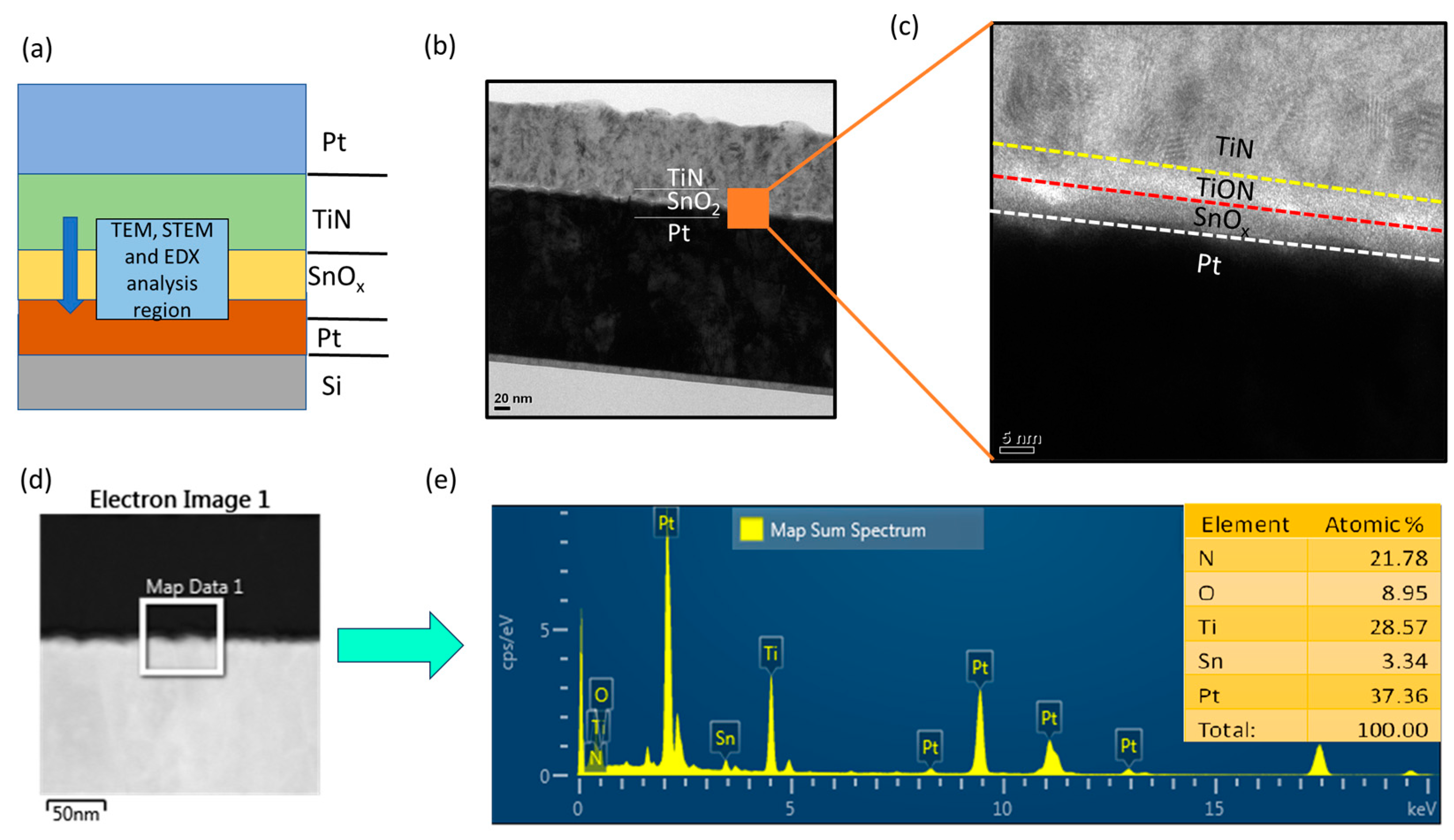
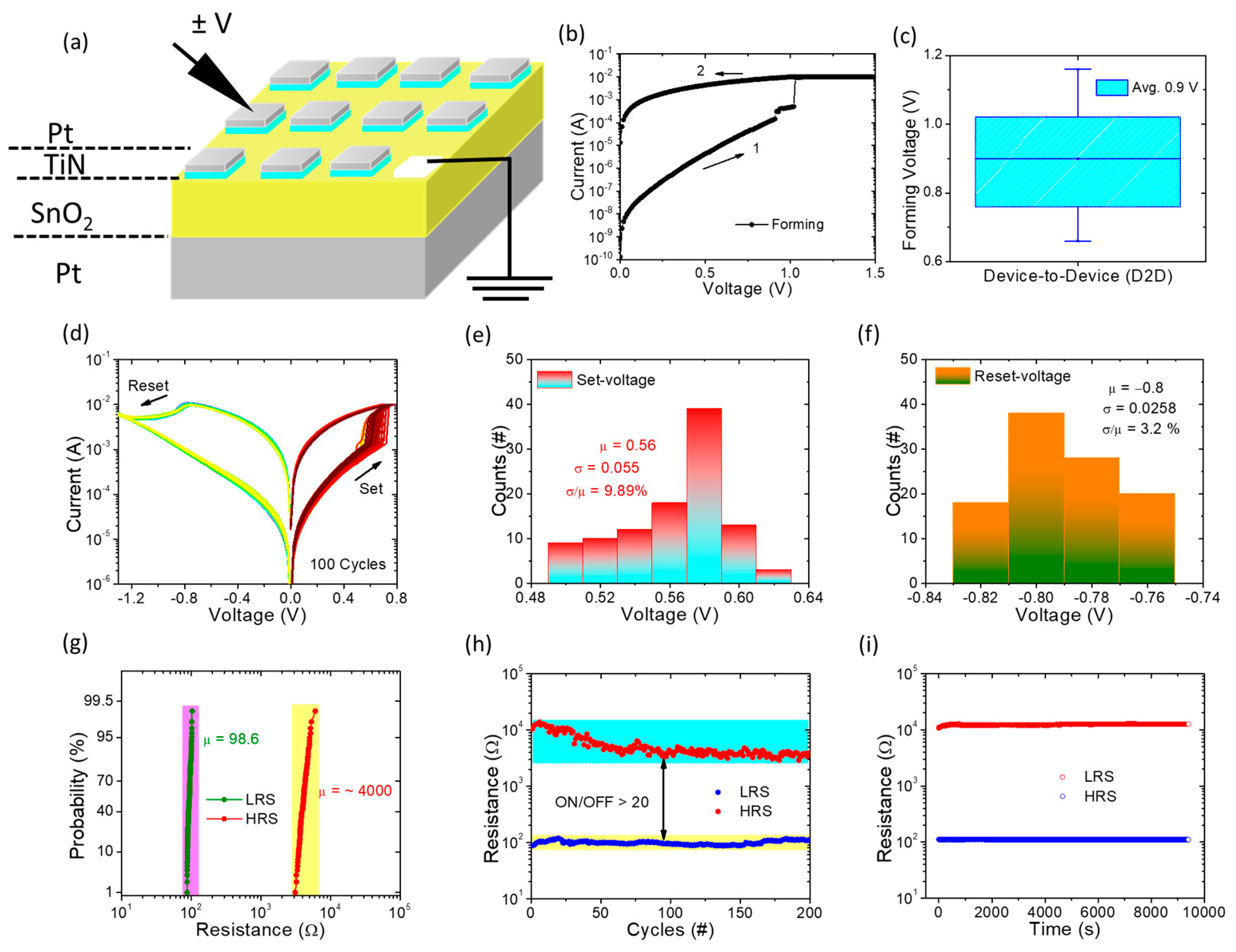
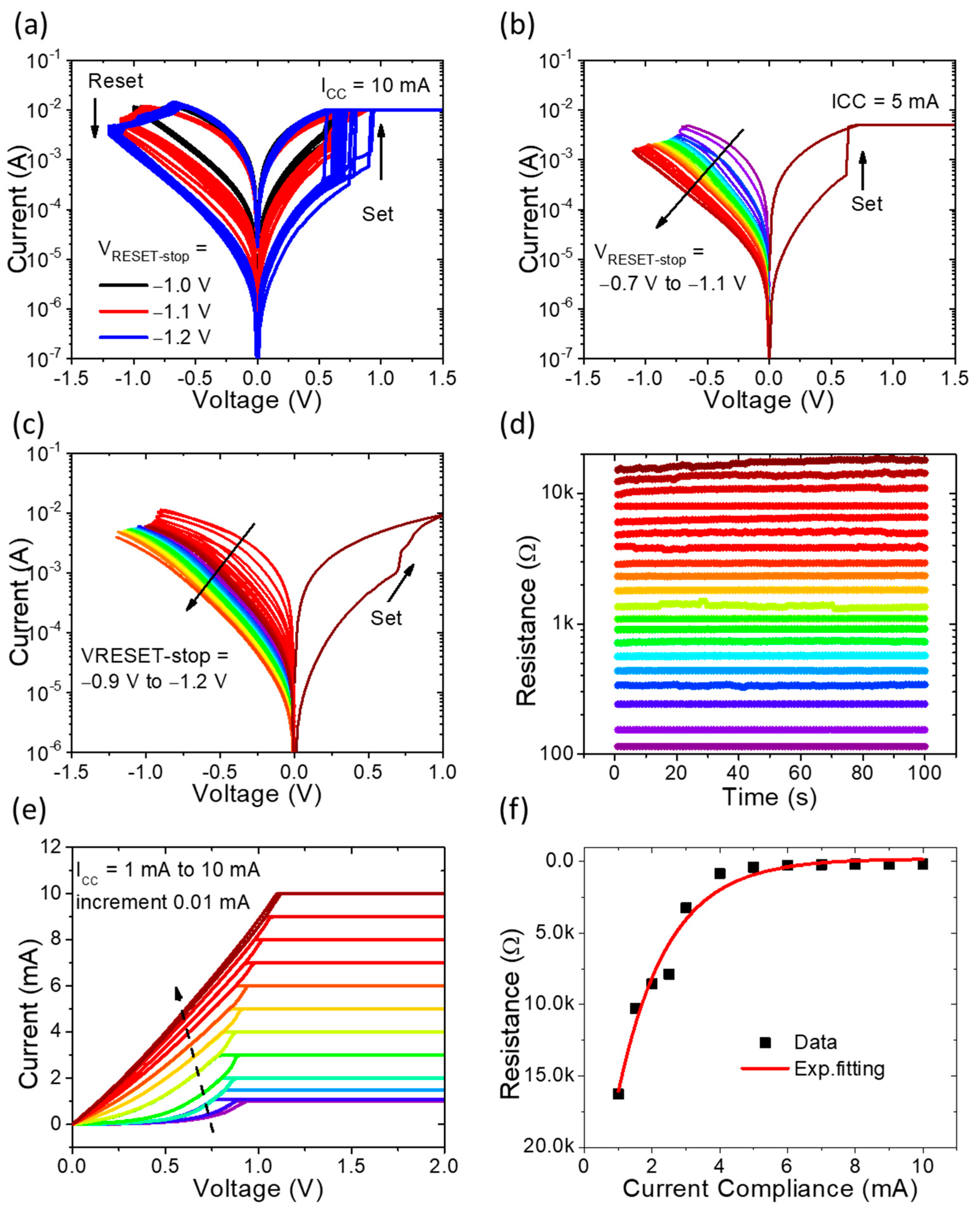
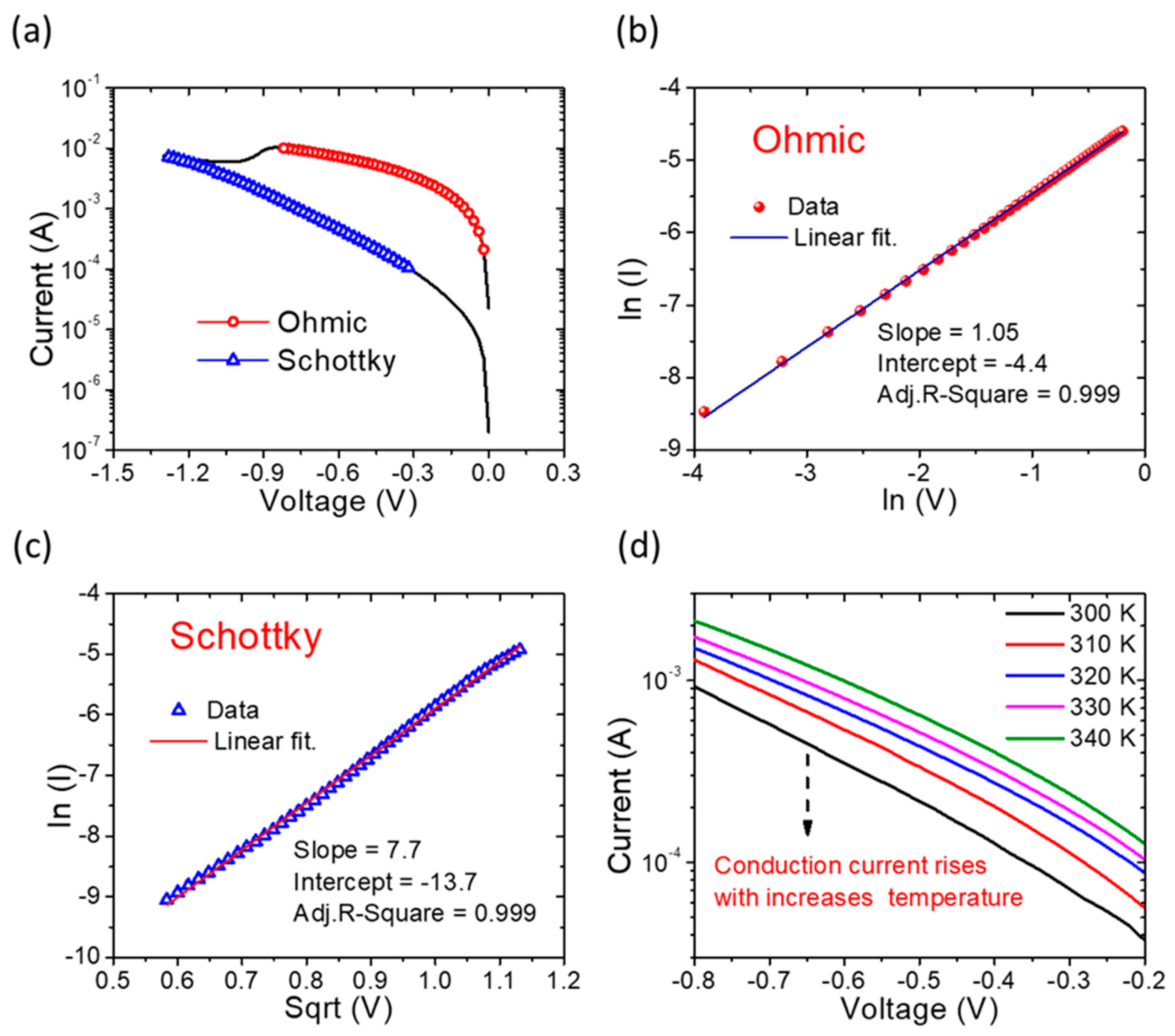
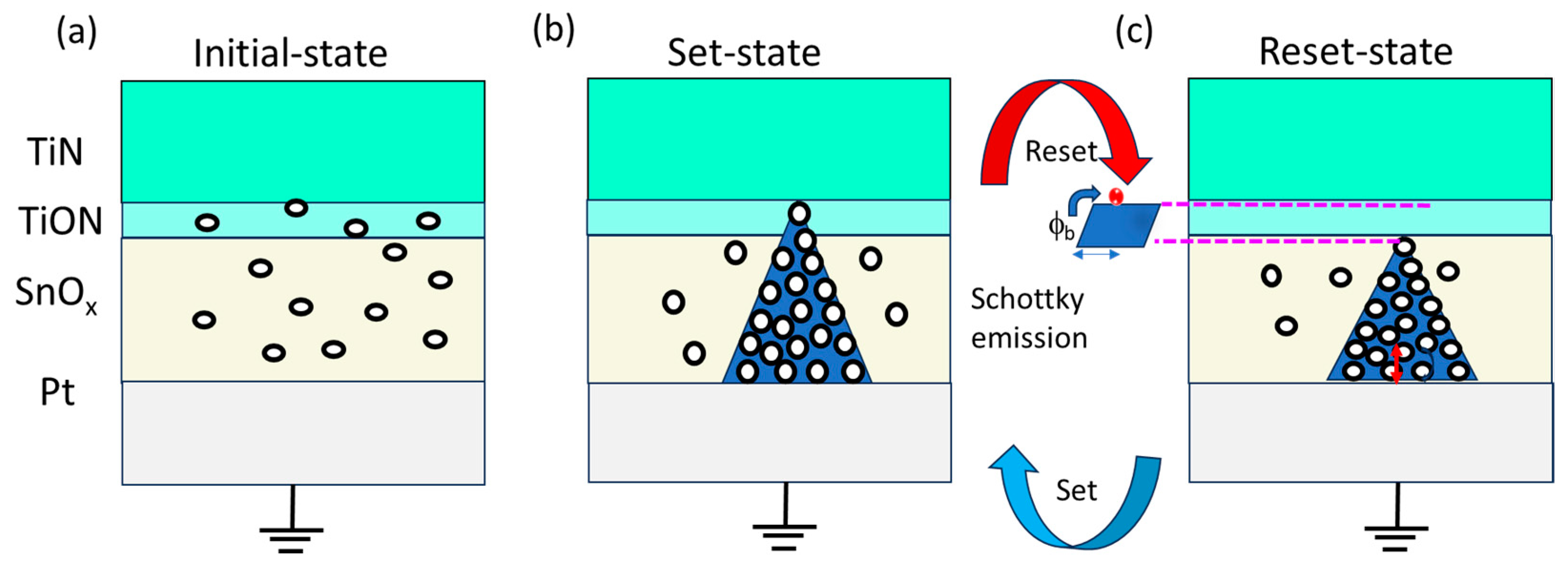

Disclaimer/Publisher’s Note: The statements, opinions and data contained in all publications are solely those of the individual author(s) and contributor(s) and not of MDPI and/or the editor(s). MDPI and/or the editor(s) disclaim responsibility for any injury to people or property resulting from any ideas, methods, instructions or products referred to in the content. |
© 2023 by the authors. Licensee MDPI, Basel, Switzerland. This article is an open access article distributed under the terms and conditions of the Creative Commons Attribution (CC BY) license (https://creativecommons.org/licenses/by/4.0/).
Share and Cite
Ismail, M.; Mahata, C.; Kang, M.; Kim, S. SnO2-Based Memory Device with Filamentary Switching Mechanism for Advanced Data Storage and Computing. Nanomaterials 2023, 13, 2603. https://doi.org/10.3390/nano13182603
Ismail M, Mahata C, Kang M, Kim S. SnO2-Based Memory Device with Filamentary Switching Mechanism for Advanced Data Storage and Computing. Nanomaterials. 2023; 13(18):2603. https://doi.org/10.3390/nano13182603
Chicago/Turabian StyleIsmail, Muhammad, Chandreswar Mahata, Myounggon Kang, and Sungjun Kim. 2023. "SnO2-Based Memory Device with Filamentary Switching Mechanism for Advanced Data Storage and Computing" Nanomaterials 13, no. 18: 2603. https://doi.org/10.3390/nano13182603








